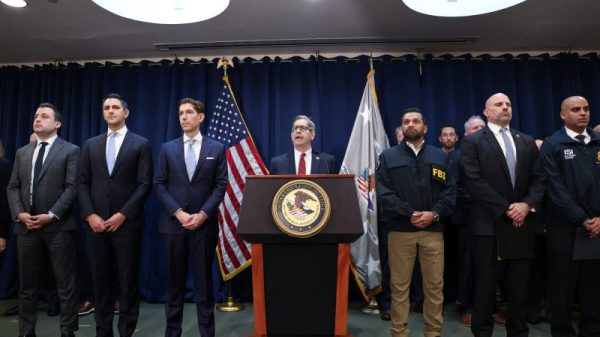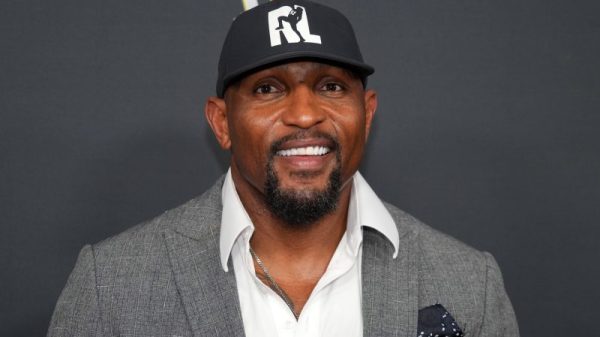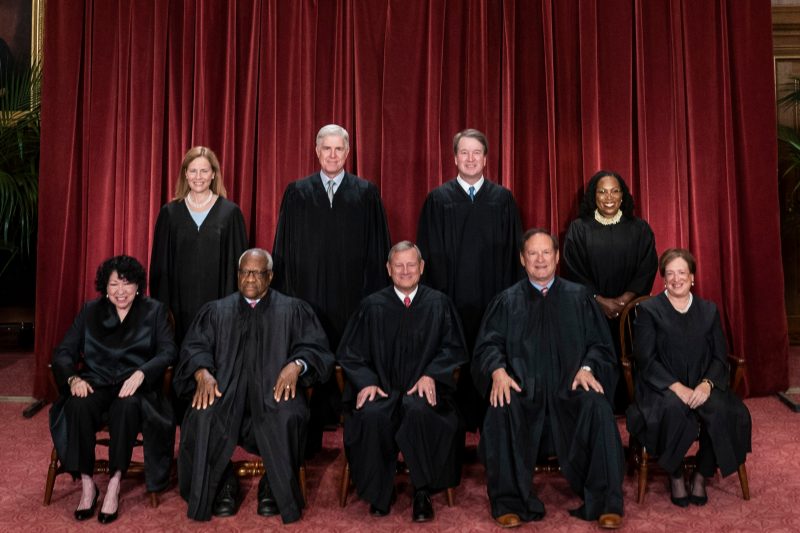The brawny display of conservative power that closed the Supreme Court term this week reinforced one truism about the court and obscured another.
A trio of ideologically divided, 6 to 3 decisions — rejecting affirmative action in college admissions, favoring the speech of the religious over anti-discrimination laws and torpedoing President Biden’s plan to forgive student loan debt — showed the abiding dominance of the court’s conservative supermajority.
But they were among only a handful of decisions — five, as opposed to 14 last term — in which those ideological lines held.
Over the course of an unpredictable and tumultuous term, Clarence Thomas and Samuel A. Alito Jr., the most conservative justices, dissented more often from the court’s decisions than its most liberal members, Sonia Sotomayor and Ketanji Brown Jackson, according to figures compiled by the website Empirical Scotus.
The court shied away from audacious asks from the right — activists on the left don’t bother asking much of these justices — and in some cases found narrow compromise in cases that could have culminated in more controversial rulings.
“I really do feel like that this term was a tale of two courts — one that remains boldly conservative and willing to revamp its precedent to achieve long-standing conservative objectives, and another that is seeking to find common ground where possible and seemingly sensitive to the sustained attack on its legitimacy,” said Gregory G. Garre, a Supreme Court practitioner who served as solicitor general under President George W. Bush. “But on the most important questions to this court, it is the muscular conservative court that prevails.”
Adam Unikowsky, a Washington lawyer who clerked for Justice Antonin Scalia and now practices before the court, agreed it was a term of “mixed messages.”
A through-line?
“In big social cases, I think lineups will stay stable” Unikowsky said. “In religion cases, gay rights cases, the outcome is predictable, in my opinion. And that’s been true for a few years, and that will continue to be true.”
If there was another lesson from the term, it was this: As went Chief Justice John G. Roberts Jr. so went the court.
Completing his 18th term, Roberts was in the majority in every one of the court’s most important cases, and chose to write the opinions in four of them. It was a remarkable turnaround from last year, when he was unable to persuade his conservative colleagues not to overturn Roe v. Wade, the most defining decision of the court’s recent history.
The ruling triggered a dramatic drop in the public’s approval of the court. And over the past year, revelations about lavish gifts and travel bestowed on some justices led to demands to strengthen the court’s ethics and financial disclosure policies.
“The term began with Justice Thomas seemingly in control of the court for the first time, with the chief justice’s influence diminishing, but those tables have dramatically turned,” said Harvard law professor Richard Lazarus, a close watcher of the court.
“Although the chief justice has struggled mightily under rising public expectations to address ethical issues within the court — mostly focused on Justice Thomas — the chief justice remains the most influential justice on the court.”
Said Garre: “Given the current makeup of the court, this arguably is his most remarkable term as chief.”
That does not necessarily mean there are tensions on the court’s right flank, only that there are varying degrees of conservatism among the justices. As Sarah Harris, a former Thomas clerk who argued before the court this term, put it in an email:
“It’s the Chief’s world (at least this Term).”
The issues the court confronts change each year, and the ones tackled this term aligned with Roberts’s long-held views. He has never voted in favor of an affirmative action program; his decision striking the admissions programs at his alma mater Harvard and the University of North Carolina is a continuation of the aversion to race-based plans he expressed in 2007, in cases involving public schools in Seattle and Louisville.
Roberts’s rejection of the Biden’s administration’s claim of power to forgive student loan debt for more than 40 million Americans was an echo of his ruling last term that the Environmental Protection Agency lacked the authority it had staked out over climate change. His vote in 303 Creative v. Colorado, holding that a Christian web designer has a First Amendment right to withhold her services from same-sex weddings, was no surprise either, because of past rulings on religious rights.
All three rulings brought passionate dissents from the bench from Sotomayor and Justice Elena Kagan. First-year Justice Ketanji Brown Jackson penned a blistering dissent in one of the affirmative action cases.
But their ability to influence the court’s conservative supermajority proved limited.
For that reason, what many saw as the emergence of a new center of the court, composed of Roberts and Justices Brett M. Kavanaugh and Amy Coney Barrett, was of little comfort to liberal advocates and organizations.
There may be a center, but it is not centrist, said Janai Nelson, president and director-counsel of the Legal Defense Fund. If the court’s rulings can be unpredictable, “so is Russian roulette,” she said.
A middle of the court occupied by Roberts, Kavanaugh and Barrett, all reliable conservatives, “just suggests the court is really far to the right,” added Melissa Murray, a New York University law professor and co-host of a liberal podcast about the court called Strict Scrutiny.
“It’s not a normal court,” opined President Biden on Thursday, after the affirmative action decision. And that was a day before the justices struck down his loan-forgiveness program.
But there were surprises, including from Roberts. He wrote the decisions in both voting cases that were praised by liberals and Democrats. One found Alabama had diluted the voting strength of Black residents by not creating a second congressional district among the state’s seven where minorities might have a good chance of electing a candidate of their choice.
The other rejected the independent state legislature theory that some conservatives had advanced in the wake of President Donald Trump’s 2020 election defeat, as dozens of false claims of election fraud were being defeated in state court. A decision to uphold the theory would have brought about a radical change in the power of state legislatures to conduct redistricting and regulate federal elections without such oversight.
Those cases, plus a challenge to the federal law that gives tribe members preference in custody and adoption of Native American children, “attracted huge amounts of doom-and-gloom prognostications from people unhappy about where they expected the court to go, and the court defied those predictions,” said Harris.
David Cole, legal director of the American Civil Liberties Union, agreed that this term was different from the last. His organization was on the losing side in 13 of the 18 cases in which it filed briefs last year, but had a winning, 11-7 record this term.
“What seems clear is that everyone overread last term, and thought everything was up for grabs,” Cole said. “The right advanced extreme arguments that the court rejected,” especially in the Alabama and independent state legislature cases, he added.
The justices’ caution was evident in the court’s “shadow docket” cases as well. They turned down requests to move quickly on controversial issues, opting instead to wait until lower courts had completed their review.
The justices restored — for now — the status quo on the availability of medication abortions, declined a request to reinstate West Virginia’s ban on transgender athletes in girls sports and put aside an attempt to block New York’s new restrictions on concealed firearms. In all three decisions, only Thomas and Alito noted concern.
Some observers said they sense an occasional separation between those two justices and President Donald Trump’s three nominees. “Justices Kavanaugh, Barrett, and even [Neil M.] Gorsuch at times have rejected the more conservative views of Justices Thomas and Alito in many of the term’s most high profile cases,” Lazarus said. “The court’s rulings have whipsawed both ends of the ideological spectrum, neither one of which tolerates exceptions.”
To the Legal Defense Fund’s Nelson, a silver lining was hard to find; the decisions on affirmative action and in 303 Creative overshadowed the rest of the term, she said. “The court had an opportunity to not completely lose all public confidence and integrity and I think in some ways its efforts in that regard failed.”
Kristen Waggoner, president of Alliance Defending Freedom, which represented the Colorado web designer, not surprisingly had a different take, noting the increase in unanimous decisions compared to last term.
“Even when the court was divided, the fault lines rarely fell along the ideological lines one might expect,” she said. In a constitutional case involving California’s laws on humanely raised pork, the decision limiting the Clean Water Act, a case involving online threats and the voting rights cases, she noted, “at least one justice — often more — crossed the so-called ideological divide.”
That was easy to forget in the closing days. Sotomayor read parts of two dissents at length from the bench, signaling her profound disapproval, and what Lazarus saw as her stepping into the role of senior justice on the left.
‘Sotomayor made clear as the Court recessed for the summer her willingness to shatter some norms about public criticism of her colleagues in their presence,” Lazarus said.
Harris thought the most important moment of the term came in Roberts’s opinion in the student-debt case, when he “seemed to break the fourth wall and speak to the public at large.”
“It has become a disturbing feature of some recent opinions to criticize the decisions with which they disagree as going beyond the proper role of the judiciary,” Roberts wrote, declaring that the justices had “employed the traditional tools of judicial decisionmaking” in making their rulings. “It is important that the public not be misled either,” the chief justice continued. ‘Any such misperception would be harmful to this institution and our country.”
But as they say in scary movies, the call was coming from inside the house.
“From the first page to the last, today’s opinion departs from the demands of judicial restraint,” Kagan wrote in her dissent to Roberts’s opinion. She added: ‘Justices throughout history have raised the alarm when the Court has overreached … It would have been ‘disturbing,’ and indeed damaging, if they had not.”
Ann E. Marimow and Alice Crites contributed to this report.



























